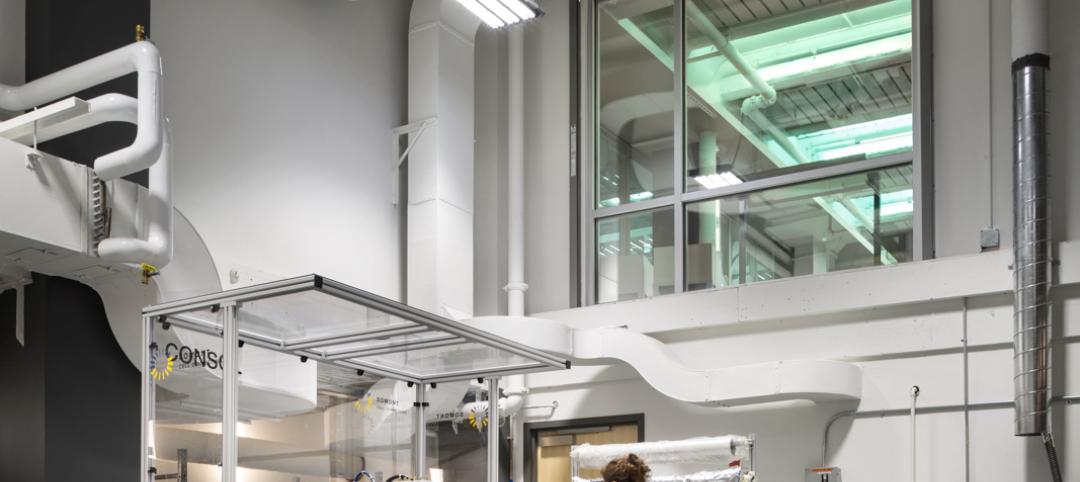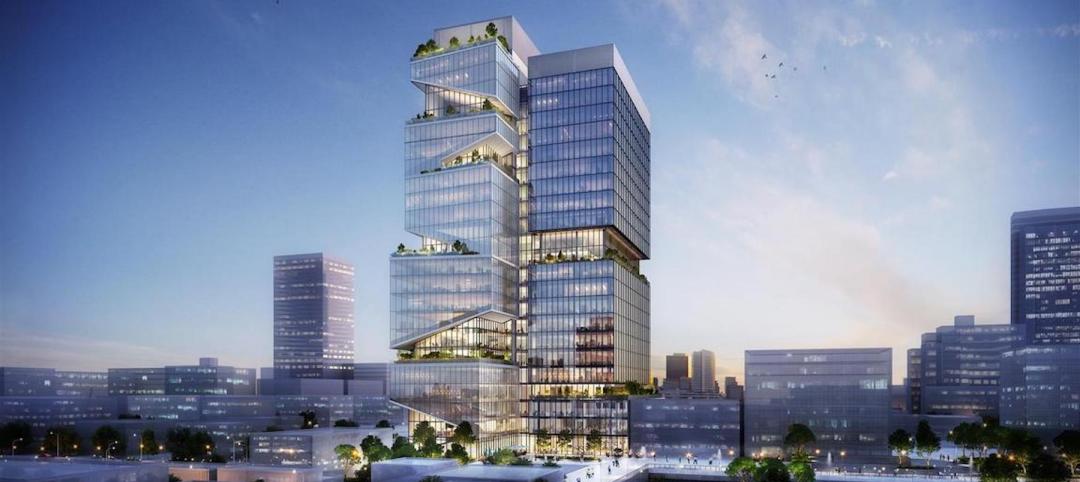An R&D building on the Billerica, Mass., campus of EMD Serono—a biopharmaceutical business of Merck KGaA, Darmstadt, Germany that focuses on specialty care—became the first in the United States to receive Gold-level certification for New and Existing Buildings from the International WELL Building Institute.
The Sagamore Building, as it is known, is part of a three-building, 275,000-sf campus with more than 500 employees who work to accelerate R&D innovation in oncology, immune-oncology, and immunology. The campus is one of four global R&D hubs for the company.The Sagamore Building, which was completed last year, has also earned LEED Platinum certification from the U.S. Green Building Council.
To achieve WELL certification, EMD Serono started with a two-day design charette that included architects, engineers, designers, and facilities managers who brainstormed, built models, and challenged notions of space. (The Building Team included Boston-based architect Ellenzwieg.)
To meet WELL’s building standard, the project—which included a new addition and a retrofit of an existing building—installed WELL-compliant lighting fixtures, and MERV 15 high efficiency air filters under ASHRAE 52.2/MERV. EMD Serono also changed to compliant cleaning chemicals and protocols, and increased its preventive maintenance schedules to quarterly, with photographic documentation of service.

EMD Serono's Sagamore Building offers its employees a variety of healthier spaces in which to work and collaborative. Image: EMD Serono
Employees now have a variety of work environments to choose from, including open spaces, huddle rooms, and designated technology-free quiet zones. WELL also requires stairs between floors to encourage exercise and occupant movement. The design of the Sagamore building’s bleacher seating and auditorium was conceived during the design phase. The seating’s construction involved rebar and build forms that were supported with special staging for several concrete pours.
The Sagamore Building underwent testing and a final evaluation by Green Business Certification Inc. (GBCI), WELL’s third-party certification entity, which corroborated that the built environment was designed to improve occupants’ nutrition, fitness, mood, sleep patterns and performance.
Anthony Meenaghan, EMD Serono’s Senior Director, Facilities Management and Engineering, Environmental Health & Safety, says the WELL certification highlights his company’s collaborative and knowledge-sharing culture. “Offering employees an environment where they can do their best work plays an important role in bringing meaningful solutions to people with difficult-to-treat diseases.”
Related Stories
| Aug 8, 2022
Mass timber and net zero design for higher education and lab buildings
When sourced from sustainably managed forests, the use of wood as a replacement for concrete and steel on larger scale construction projects has myriad economic and environmental benefits that have been thoroughly outlined in everything from academic journals to the pages of Newsweek.
Laboratories | Jul 17, 2022
Renovation is filling the need for life sciences lab space
Three experts from the firm DiMella Shaffer discuss the advantages and challenges of converting existing buildings.
Laboratories | Jun 29, 2022
The "collaboratory" brings digital innovation to the classroom
The Collaboratory—a mix of collaboration and laboratory—is a networking center being designed at the University of Denver’s College of Business.
Museums | Jun 28, 2022
The California Science Center breaks grounds on its Air and Space Center
The California Science Center—a hands-on science center in Los Angeles—recently broke ground on its Samuel Oschin Air and Space Center.
University Buildings | Jun 7, 2022
Newfoundland university STEM building emulates natural elements, local traditions
Memorial University of Newfoundland (MUN) recently opened a new building that will provide interdisciplinary learning and research space for Faculties of Science and Engineering.
Laboratories | May 20, 2022
Brutalist former Berkeley Art Museum transformed into modern life science lab
After extensive renovation and an addition, the former Berkeley Art Museum and Pacific Film Archive at the University of California, Berkeley campus reopened in May 2022 as a modern life science lab building.
Laboratories | Apr 29, 2022
Oracle Industry Lab in Chicago enables development of solutions for multiple industries
The Oracle Industry Lab in Chicago, which provides customers in multiple industries the opportunity to test new technologies, recently opened.
Laboratories | Apr 7, 2022
North Carolina's latest play for biotech real estate development
The Tar Heel State is among a growing number of markets rolling out the welcome mat for lab spaces.
Projects | Mar 11, 2022
Studying science in the sky
In sharp contrast to other types of commercial real estate, the life sciences market is booming, according to SGA, an architecture firm based in Boston and New York that has extensive experience designing life sciences buildings.
Laboratories | Feb 10, 2022
Historic building becomes a research science incubator
Svigals + Partners designed the project.

















